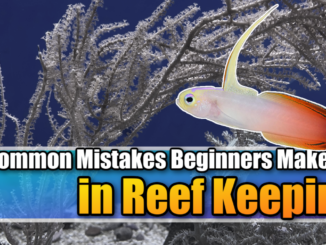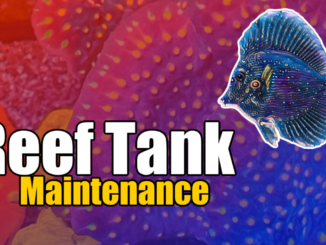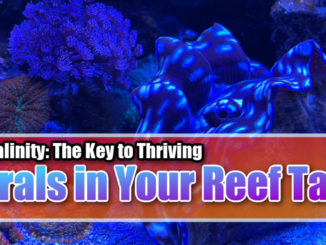
What is Aquarium Husbandry?
The first time I heard the term aquarium husbandry I was at a bit of a loss, even with my back ground in environmental science. I never conceded using that term as a way to label the way I maintained my saltwater aquarium. Simply put, aquarium husbandry is a term used by advanced and expert aquarium hobbyist to define the care of an aquarium.

When it comes to maintaining a saltwater aquarium, many hobbyist can find them selves repeating the same aquarium maintenancethey’ve always done. One of the keys to success with saltwater aquariums is constantly improving your ability to care for your aquarium. Aquarium keeping methods and aquarium equipment are constantly changing and improving. To find success, a hobbyist must keep up to date in the latest information regarding aquarium husbandry.
I would like to invite you to subscribe to my newsletter, it’s a great way to stay up to date on newly added content to Mad Hatter’s Reef as well as exclusive content that you can not find here on the blog.Below you will find a huge list of ways to improve saltwater aquarium husbandry, for your own aquarium. Even if you only choose to only place a handful of these practices to work, you will see an improvement in your aquarium’s heath.
20 Ways to improve Aquarium Husbandry.
Water Changes.
- A 10% (of the total volume of the aquarium) water changeshould be done weekly for the first year of the aquariums life. This does two thing for the saltwater aquarium. It removes nitrate and phosphate form the aquarium as well as replenishes beneficial nutrients back into the aquarium. After the first year of the aquarium’s life you can start to rely on water parameter testing to indicate when you need to make a water change (keeping nitrate levels below 10 ppm).
Protein Skimmer.
- In my opinion, no one should ever consider having a saltwater without a protein skimmer. Considered a supplemental filtration device, they reduce nitrate levels in the aquarium by removing waste from the water column, before the waste has a chance to breakdown. Utilizing a protein skimmer can reduce the need for water changes, increase the levels of dissolved oxygen in the water and help support proper PH levels.
light Bulbs.
- Do you replace your bulbs annually? Replacing your saltwater aquarium lighting every 9-12 months can have a huge impact on your aquarium husbandry. Over time, the light spectrum of bulb can change. This can have a negative impact on your aquarium. Nuisance algae blooms and damage or death to SPS corals. Some Hobbyist write the install date, right on the bulbs with a sharpie as a reminder.
UV Sterilizer.
- Most commonly known for their ability to provide extreme water clarity, they can aid in the control of parasites, such as Ich. It’s important to know that UV exposure does not kill organisms that pass through the unit. UV sterilizers use radiation to sterilize single cell organisms and some small parasites so they can no longer reproduce, effectively killing them off. The are a great preventive measure for any saltwater aquarium.
Parameters Testing.
- Do you test your water parameters? Staying up to date on water quality testing will help you make informed decisions as to what kind of maintenance your saltwater aquarium is in need of. Testing your water should be done before any other weekly maintenance to see how your aquarium is running. If you find that some water parameter levels are out of range, re-test them after you have made adjustments.
Cleaning Equipment.
- Cleaning equipment once a month will not only extend the life of the equipment but it can ensure proper performance. This can also serve as a great time to inspect the condition of your equipment. Helping you be aware of any future replacement that may be needed. All that is needed to clean aquarium equipment is a new toothbrush, distilled vinegar and RO/DI water. Remove all calcium carbonate and salt creep to get the most out of your equipment.
GFO reactor.
- GFO: (Granular Ferric Oxide) GFO removes phosphate from the aquarium. Using GFO can have a huge impact on your aquarium husbandry. It looks similar to carbon and they are often used together. It is recommended to change GFO every couple of weeks to keep it effective.
Water Evaporation.
- Not topping off water evaporation daily will cause the salinity to raise. While this gradual increase may not have a noticeable effect on your livestock, a week’s worth of evaporation can add up. Playing the catch up game with water evaporation can be a losing battle. Too much freshwater added to the aquarium at one time can rapidly decrease salinity will stress fish, invertebrates and corals.
- I use air line to replace water levels it look like a reverse drip acclamation going into my sump. I find this is the best way to add freshwater to my aquarium and it free me up to perform other aquarium maintenance.
Drip Acclimation.
- Do you use drip acclimation? Slow and steady wins the race. This philosophy is the key to success when it comes to saltwater aquariums and it’s no different when it comes to adding marine fish to your aquarium. No two aquariums are the same and water used to ship marine fish, invertebrates and corals should never enter your aquarium. It will contain different water parameters such as temp, pH, and salinity (not to mention possibly disease and parasites). Fish, invertebrates, and corals are very sensitive to even minor changes in water parameters, so proper acclimation is the key to ensuring a successful acclimation.
Increase dissolved oxygen.
- Most peopleunderstand that all living thing need oxygen to live, but many do not take under consideration the need for dissolved oxygen levels in their saltwater aquarium. Marine fish, coral, invertebrates and bacteria consume oxygen and expel carbon dioxide at a constant rate. Excessive carbon dioxide level can lead to algae blooms and cyanobacteria outbreaks. You can increase your dissolved oxygen level by using a protein skimmer or using an air stone and pump, in the aquarium sump.
Remove uneaten food.
- Overfeeding is placing more food in the aquarium than the fish can eat. Uneaten food decomposes quickly, releasing an abundance of organic matter that can send nitrate levels sky high. This can cause allergy blooms, cyanobacteria outbreaks as well as a decrease in dissolved oxygen levels. It’s best to feed in small portions only what your fish can eat in 2 to 3 minutes. If you see any uneaten food scoop it out with a fish net.
Clean-Up Crew.
- Do you ever restock your clean-up crew? This is often overlooked, overtime your clean-up crew will drop in numbers as a result of predation and natural death. Its a good idea to restock your clean up crew every six months or so.
- A clean up crew is a set of invertebrates put together with one goal in mind cleaning your saltwater aquarium. Different invertebrates serve different proposes that why it’s very important to have a variety. Hermit crabs are great for eating detritus and uneaten food. Where snails are great for eating algae. I’ve always done well with the 1 hermit cab and/or snail per gallon of aquarium philosophy.
- I also prefer invertebrates on the smaller side for my clean up crew because corals and live rock can get knocked around. It’s also important to keep in mind to keep your crew stocked up because this little critters do not have long life span.
RO/DI Unit.
- Tap and even bottled water often have contaminates within them that can cause complications when added to your saltwater aquarium. These contaminates may include phosphates, nitrates, chlorine, and metals. The job of a RO/DI unit (Reverse Osmosis and Deionization unit) is to remove all of the contaminates. The propose of a water change is to remove nitrate and phosphate form the aquarium but if you are starting with water that already contains impurities, your saltwater aquarium will most likely crash.
Carbon Reactor.
- Carbon: Carbon helps the water look crystal clear as well as removes dissolved organic compounds from the water. Carbon is often used with GFO in saltwater aquariums. It’s recommended to change every couple of weeks to make it effective.
Deep Sand Bed.
- A deep sand bed can add numerous benefits to a saltwater aquarium. The most important of these benefits is its effect on water quality and the aquarium’s beneficial filter. A properly working biological filter is based on nitrifying bacteria and it’s ability to breakdown the bio-load of the aquarium’s livestock.
- The biological filtration makes the water less toxic for marine fish, Invertebrates and coral. How effective your beneficial bacteria is, depends on the total surface area as well as how stable the bio-load is within the aquarium. Deep sand bed equals long term stability; Long term stability equals success.
Quarentine Tank
- I highly recommend, that all new fish should be placed into a quarantine tank for a few weeks before being added to the display tank. This will reduce the possibility of introducing diseases and parasites into your aquarium. During the quarantine process, make sure the new fish accepting foods, eating properly, and is in good health before adding them to the display tank.
- Do you have a separate small (say 10-gallon) tank set-up as a quarantine / hospital tank? You should. Having this tank on hand is essential to good husbandry. All new fishes and corals should be quarantined before being added to an established system, and many parasites and diseases are best treated in an isolated environment. While you can plan for new arrivals, you can’t plan for when parasite outbreaks or diseases will strike. Set up a QT / Hospital tank today.
Over Cleaning.
- Regular aquarium maintenance such as filter pad replacement, substrate vacuuming or even water changes can have a negative impact on the biological filtration to some degree. If your water is not properly filtered through a RO/DI unit, the chemicals and metals present in the water and can kill off the bacteria when added to the aquarium. No water changes greater than 25% of the total volume should be done at one time.
Detritus Traps.
- Any dead spot in a saltwater aquarium will with out a doubt become a detritus trap. The problem with detritus is that it is a particulate of organic material (most likely from a dead organism or fecal matter from a living one) that will effect the water quality. A common place to find detritus accumulated at the bottom of an aquarium overflow. Another common place for detritus to accumulate is within the aquascape (rock work) of the display tank.
- It’s best to prevent these dead spot from occurring i the first place but when these spots can not be avoided they needed to be cleaned out as often as possible. This will help improve aquarium husbandry and prevent a tragedy.
Refugium
- Do you have a refugium plumbed to your display tank? You should. Many fishes and other animals benefit from a refugium, which cultivates foodstuff that would not survive in the display tank. Healthy pod populations and macroalgae growth can prove critical to successfully keeping many hard-to-keep species, but almost all animals will benefit from a mature refugium. In addition to direct benefit to your animals through diet, a refugium on an alternate light cycle (refugium lights on at night) can help to stabilize daily fluctuations in pH and can provide a mechanism for nutrient export.
Automation.
- Aquarium automation can give you a huge advantage and can help your aquarium husbandry. Putting your aquarium on auto pilot can be as easy as the flip of a switch, but can control more complex systems such as topping off water due to evaporation, dosing additives at a constant rate. controlling lights though out the day (even shutting them down if the aquarium gets to hot) and water movement. Aquarium controller such as the Neptune Systems Apex can give any die hard reefer a much needed day off.
So, there you have it. 20 simple, yet effective ways for improving your aquarium’s husbandry. Put 1 or all of them to work and you be glade you did. Let me know what you think, If I left anything out be sure to leave a comment below.
I just wanted to say thank you for your support and I would love for you to drop me a line on my Facebook Page. I look forward to meeting you.
P.S. If you found this page helpful, please hit the share button below.




